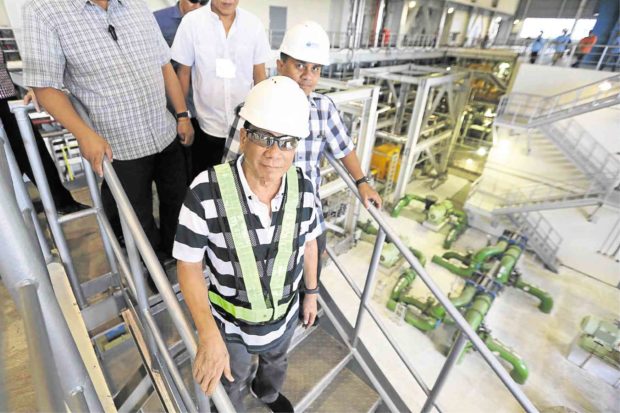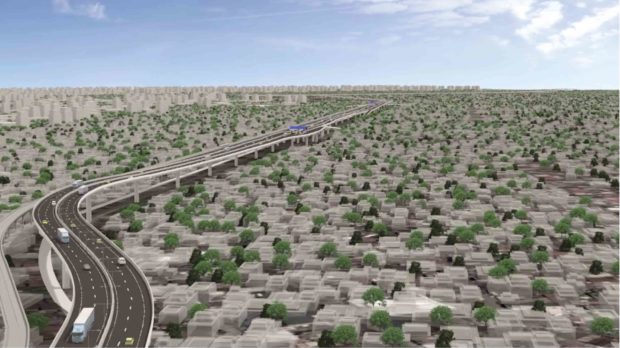Duterte rolls out legacy projects
July 4, 2017 at 14:00
Duterte rolls out legacy projects
Unlike in the previous administration, government projects under President Duterte would rely less on private partnerships, and more on public spending and overseas development loans

OCULAR INSPECTION President Duterte leads the inspection of a coal thermal plant in Villanueva, Misamis Oriental province, on Sept. 22, 2016. —MALACAÑANG PHOTO
While the Duterte administration has courted near-constant division over its polices on politics, security and foreign policy, it has unified critics and allies alike on the country’s crucial need for infrastructure.
On its first year, the administration made clear that the implementation of its projects — from new roads, airports and railway lines — would shift drastically from the policies of the Aquino government.
Described by Duterte officials as a “golden age of infrastructure,” the “build, build, build” program calls for about P8 trillion in public and private spending during the President’s term until 2022.
Among the so-called “legacy projects” that the Duterte administration plan to roll out during his term are the P227-billion Mega Manila Subway; the P105.3-billion Philippine National Railways (PNR)-North South Commuter Rail; the P150-billion PNR North-2; the P134-billion PNR South Commuter; the P151-billion PNR Long Haul; the P80.41 billion Mindanao Logistics Infrastructure Network; the P57.6-billion Subic-Clark Cargo Railway Project; the P26.65-billion Metro Manila Skyway Stage 3; the P21.9-billion Bonifacio Global City to Ninoy Aquino International Airport (Naia) bus rapid transit system; the P18-billion Metro Cebu Expressway; the P19.8-billion Davao City By-Pass, and the P14.9-billion Central Luzon Link Expressway.
Mr. Duterte’s government wants to set infrastructure spending at 5.3 percent of the economy this year against an average of 2.9 percent during the Aquino administration. The plan is to bring this up to more than 7 percent by 2022. The goal of such massive spending is to support growth, officials said.
The other objective is to cut crippling traffic in major urban areas across the country, a problem likely to stay a while longer since many of the larger projects like trains and new roads would be completed by 2020 and beyond.
About 60 projects valued at close to P1.8 trillion have been identified under the “build, build, build” program, most of them aimed at easing land, air and sea bottlenecks. About P1 trillion of these are train projects alone.
The call for better infrastructure is reminiscent of the public-private partnership (PPP) program launched by former President Benigno Aquino III early on in his administration.

Carry-overs
Indeed, many of the largest “build, build, build” projects are carry-overs from the last six years.
Aquino’s PPP program, thus far, gave Filipinos two new toll roads (the Muntinlupa Cavite Expressway and Naia Expressway Phase II), the Beep card system for elevated trains and more public classrooms.
Other ongoing projects include the new passenger terminal in Cebu’s main airport, the Cavite Laguna Expressway, and important bus hubs in the southern part of the capital.
Still, the PPP promise fell short of expectations, with the previous administration failing to launch most of the projects in its pipeline.
Where the Aquino administration leaned more on the private sector for financial backing of its infrastructure goals, the Duterte administration signaled that it wanted to go a different direction.
According to the National Economic and Development Authority (Neda), government spending via General Appropriations Act (GAA) funding would account for the lion’s share, or 66 percent of project cost through 2022.
More emphasis was also being placed on overseas development assistance loans, which would account for 15 percent.
Beijing loans
Under Mr. Duterte, diplomatic ties with China have warmed considerably and there is a business end to this move.
Loans from Beijing are now being eyed to finance various projects, including a train line that would link Manila to the Bicol region—a project once classified under the PPP program.
A loan from the Japanese government would be used to build the P227-billion Mega Manila subway line, the country’s first underground train. This was also previously part of the PPP pipeline.
PPPs, according to Neda, would still account for 18 percent of funding, a figure that many in the private sector consider doubtful.
There was no new PPP project among the 60 projects cited in the “build, build, build program,” although private sector investors interviewed by the Inquirer acknowledged that it was still too early to tell.
It is in the new PPP policy where a clear fault line between the government and private sector has emerged.
Under the Duterte administration’s hybrid PPP policy, government would source project funding through the GAA, or official development assistance (ODA) scheme, but would potentially auction off to the private sector the operations and maintenance (O&M) component once the project was completed.
This was a big shift from the previous PPP policy where the private sector would finance, design, build, and then operate and maintain a given infrastructure project.
Hybrid policy
The government wants to cut the role of the private sector prior to the O&M, saying this would mean lower costs for consumers since there would be no major investment for the private sector to recover.
Moreover, the government was wary of delays associated with PPPs, especially if bidders get embroiled in legal cases.
In this respect, the Fitch Group’s BMI Research, a global leader in financial information services, agreed with the Duterte administration.
In a recent report, BMI noted that the shift would “reduce the likelihood of contractual disputes and uncertainty over financing” that was seen as a stumbling block for some of the proposed PPPs.
The hybrid policy, however, has its critics.
Even the PPP Center, moving to allay fears among investors, is walking a fine line in supporting the new policy while seeking to close the gap between the time when a project gets designed and when the private sector gets involved.
“One best practice is for government to define the performance required during O&M even before the infrastructure is designed,” said PPP Center executive director Ferdinand Pecson.
“Another is to bid the O&M as early as possible so the private party could help the government monitor the quality of construction, and get sufficient training and familiarization with the technology employed before the start of the operation,” he added.
Vaughn Montes, who aids the PPP Center on risk management through a grant from the Asian Development Bank, said government- and ODA-funded projects also tended to suffer from time and cost overruns.
A list of 15 PPP projects that have been bid out showed that an overwhelming majority emerged cheaper compared to their Neda-approved budgets.
These savings amounted anywhere from 1 percent (in the case of school infrastructure), to 35 percent (in the case of the Naia Expressway), and 40 percent (for the Muntinlupa Cavite Expressway).
Incentive
Moreover, data compiled by Montes showed that PPPs fared better than projects funded by ODA, when it comes to period of completion from project development to groundbreaking.
For PPPs, it was a little over 25 months versus more than 35 months for Japanese and Korean ODAs, and 40 months for Chinese ODAs.
Montes’ most compelling argument was the need for private sector to have capital at risk as a powerful incentive for a project to succeed.
Neda Undersecretary Rolando Tungpalan defended the hybrid model, saying it opened up better financing options for the government.
“Many large infrastructure projects will require long-term financing, especially if these have long gestation period,” he said.
“ODA accessed by government has favorable financing terms that match the needs of such infrastructure projects better than commercial sources of our grants,” Tungpalan added.
Moreover, it was in this manner that smaller contractors had a better chance of participating in big projects, the Neda official noted.
Another big shift in the Duterte administration was its open-door policy toward unsolicited proposals.
The Aquino administration held a strong bias against this scheme, arguing that it was prone to corruption. While unsolicited projects are allowed under the law, these were mostly ignored during Mr. Aquino’s time.
In contrast, since Mr. Duterte assumed power, more than P2.6 trillion worth of unsolicited offers from the private sector have emerged, including two proposals to build a new international air gateway to serve Metro Manila either in Bulacan or Cavite province.
But despite its openness to new proposals, the Duterte administration has yet to move forward with a single new offer from the private sector during its first year./rga
Source: https://newsinfo.inquirer.net/910232/duterte-rolls-out-legacy-projects#ixzz4lvD4LqlE





















